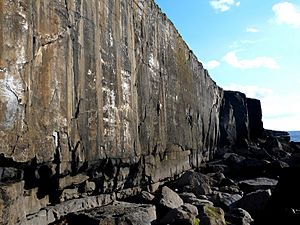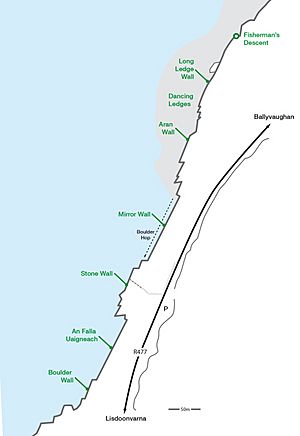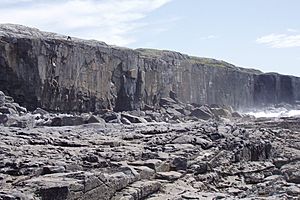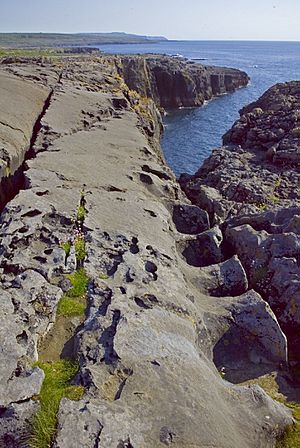Ailladie facts for kids
Quick facts for kids Ailladie |
|
|---|---|
| Aill an Daill, The Blind Man's Cliff Ballyreen Cliffs or Ballyreen Point |
|

An Falla Uaigneach, at the southern end of Ailladie
|
|
| Location | |
| Nearest city | 6 km south of Fanore 8 km north of Doolin |
| Range | The Burren |
| Coordinates | 53°04′14″N 09°21′30″W / 53.07056°N 9.35833°W |
| Climbing type |
|
| Height | circa 35 metres (115 ft) above sea level at its peak |
| Pitches | Single pitch |
| Ratings |
|
| Rock type | Limestone |
| Quantity of rock |
|
| Development |
|
| Cliff aspect | West |
| Elevation | At sea level |
| Camping |
|
| Classic climbs |
|
Ailladie, also known as the Ballyreen Cliffs, is a famous sea cliff in County Clare, Ireland. It's about 800 meters (half a mile) long and can be as high as 35 meters (115 feet). This amazing place is one of Ireland's top spots for rock climbing, especially for difficult climbs and a style called deep water soloing. Ailladie is also popular for fishing competitions and offers stunning views of the Aran Islands, making it a favorite for photographers.
Contents
What's in a Name?
The name Ailladie comes from the Irish language, Aill an Daill. This means The Blind Man's Cliff. People living nearby and those who fish often call the cliffs Ballyreen Cliffs or Ballyreen Point. This name also comes from an Irish word, Baile Uí Rinn, which means "Ring's homestead."
Exploring Ailladie's Structure
Ailladie is a long cliff made of limestone rock. It faces west towards the Atlantic Ocean. The cliff's height changes, from 8 meters (26 feet) to 35 meters (115 feet) tall.
The northern parts of the cliff are not directly in the sea. You can reach their bases by walking down special paths. However, the southern parts are true sea cliffs. To get to the bottom of these, climbers must use ropes to lower themselves down, which is called abseiling.
How to Get to Ailladie
Ailladie is a bit hidden, located just off the R477 road. You can find a car park for Ailladie marked on online maps. It's across from a climbing area known as the Stone Wall.
Next to the car park, you'll see a smaller climbing spot called Ballyryan. People driving by on the R477 road can often see climbers on its rock face.
To reach the base of Ailladie's cliffs without abseiling, you can use a 3-meter (10-foot) roped path. This path, sometimes called the "fisherman's descent," leads to a large flat limestone platform at the northern end.
Rock Climbing Adventures
Ailladie is a very popular place for rock climbing. It offers many different routes for climbers of all skill levels, though many are quite challenging.
Different Climbing Sections
The northern part of Ailladie has sections called the Dancing Ledges and the Aran Wall. These areas are easy to reach from the large rock platform below. You can get to this platform using the 3-meter roped "fisherman's descent" at the very north end. There's also a "climber's descent" at O'Conner's Corner, which is 10 meters (33 feet) long. The Dancing Ledges is the lowest part of Ailladie, with climbs that are 10–15 meters (33–49 feet) high.
The southern part of Ailladie starts with the Mirror Wall. This section has very difficult climbs, usually graded E4 to E7. You can sometimes reach it by hopping over boulders at low tide. However, many climbers choose to abseil down to the start of these climbs.
Further south are the Stone Wall, An Falla Uaigneach, and Boulder Wall sections. You always need to abseil to reach these areas. The An Falla Uaigneach section is very impressive. Many climbs here start from a "hanging belay," which means the climber is hanging from ropes before they even begin to climb. This section also has deep water soloing routes. These are very hard climbs over deep water, with drops of up to 30 meters (98 feet).
The rock at Ailladie is high-quality, clean, blue-grey limestone. It forms a mostly straight-up, vertical cliff. The rock's surface can be smooth in new areas or have a "popcorn" texture that helps climbers grip it well. Most climbs follow narrow cracks where climbers place their fingers. The safety gear, called "protection," is generally good.
The last climbing guidebook, published in 2008, listed 170 climbs. The online database now has over 200 routes. Most of these are "single-pitch" climbs, meaning they are done in one continuous section. The difficulty levels go up to E7 6c. Most climbs at Ailladie are quite hard, at or above E1 5b. There are not many easy climbs here. Sometimes, the lower parts of routes can change due to large boulders moving during sea storms. This is why climbers on the Mirror Wall often start from a hanging position.
In 2019, a climb called On Reflection (E6, 6a) on the Mirror Wall was named one of the "Five Best E6 Routes in the UK and Ireland" by UK Climbing magazine.
A Rich Climbing History
Climbers first discovered Ailladie's potential in August 1972. A group of climbers from Dublin visited and quickly spread the word about how great it was. Soon, Ailladie and other smaller climbing spots in The Burren became known as the only places in Ireland with limestone rock climbing right on the coast. Other climbing areas in Ireland are mostly made of different types of rock.
Since then, Ailladie has remained a top spot for traditional outdoor rock climbing in Ireland. It's often compared to the famous Fair Head cliff in County Antrim. UK Climbing magazine even called Ailladie the "Best coastal limestone in the world!" The Irish Examiner newspaper described it as "The mecca for rock climbing in Ireland." The Irish Times also called it "one of Ireland’s best rock-climbing sites."
Places to Stay and Other Activities
Climbers visiting Ailladie often camp in the fields above the cliffs. However, there is no fresh water available there. Many also choose to stay in hostels in nearby villages. Doolin is a popular choice, known for its lively atmosphere and extra bouldering spots. Fanore offers serviced camping grounds.
There are also several other limestone climbing areas nearby, about 10–20 meters (33–66 feet) high. These are good for easier climbs, especially below the VS grade. You can walk to some, like Ballyryan, or drive a short distance to others, such as Murroughkilly. However, none of these are as popular or as high-quality as Ailladie.
Exploring Cliff Cave
A large cave called Cliff Cave was discovered in 2012. It starts about 9.5 meters (31 feet) below sea level and goes inland from the cliffs. This cave has over 2.7 kilometers (1.7 miles) of passages, making it the longest known marine cave in Ireland.
Fishing from the Shore
The flat limestone ledges at the bottom of Ailladie's cliffs are great for fishing from the shore. Anglers, or fishermen, know these areas as Ballyreen, south of Fanore. Some rocks even have numbers painted on them for fishing competitions. Ballyreen is known as one of the few places in County Clare where anglers have caught sharks, like porbeagle and blue sharks, as well as conger eels.
Because these low ledges are so close to the deep Atlantic Ocean, it's important to be careful. Anglers must always watch out for sudden large waves, as these can be dangerous.






